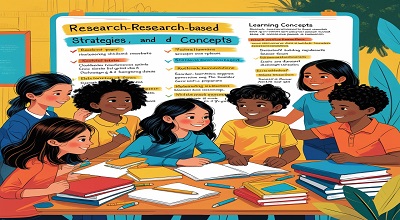Research-Based Strategies
Research-Based Strategies: In the ever-evolving landscape of education, educators must adopt research-based strategies that effectively enhance learning outcomes for elementary students. This article delves into the latest evidence-based practices that can be implemented in elementary classrooms to foster student engagement, improve academic performance, and develop essential skills. By integrating these strategies, teachers can create a dynamic learning environment that caters to the diverse needs of their students.
Understanding Research-Based Strategies
What Are Research-Based Strategies?
Research-based strategies are instructional methods that have been validated through rigorous scientific research. These strategies are designed to improve student learning by utilizing evidence from studies that demonstrate their effectiveness in real classroom settings. The goal is to provide educators with tools that are not only theoretically sound but also practically applicable.
Importance of Research-Based Strategies
Implementing research-based strategies is essential for several reasons:
- Improved Learning Outcomes: These strategies are proven to enhance student understanding and retention of information.
- Informed Decision-Making: Educators can make informed choices about instructional practices based on empirical evidence.
- Adaptability: Research-based strategies can be tailored to meet the unique needs of diverse learners in the classroom.
Key Research-Based Strategies for Elementary Students
1. Scaffolding Instruction
Scaffolding is a teaching method that involves breaking learning into manageable chunks and providing support at each stage. This approach helps students build on their existing knowledge and gradually develop independence.
- Implementation: Teachers can model problem-solving processes, guide students through collaborative work, and eventually allow them to tackle more complex tasks independently.
- Benefits: Scaffolding promotes confidence and competence in students, enabling them to take ownership of their learning.
2. Writing Strategies
Effective writing instruction is crucial for elementary students. Research suggests several strategies that can enhance writing skills:
- Opportunities for Practice: Providing students with ample chances to write, receive feedback, and revise their work is essential 1.
- Structured Writing Frameworks: Utilizing frameworks such as the writing process (prewriting, drafting, revising, editing, and publishing) can guide students through their writing journey.
- Peer Review: Encouraging peer feedback fosters collaboration and helps students learn from one another.
3. Comprehension Strategies
Teaching students how to comprehend text is vital for their academic success. Research identifies several effective comprehension strategies:
- Active Reading Techniques: Strategies such as summarizing, questioning, and predicting can help students engage with the text.
- Graphic Organizers: Visual tools like Venn diagrams and story maps assist students in organizing their thoughts and understanding complex information.
4. Building Content Knowledge
To enhance students’ understanding of various subjects, it is important to build their content knowledge systematically:
- Clear Learning Intentions: Clearly stating learning goals and success criteria helps students understand what is expected of them 2.
- Integrating Knowledge Across Subjects: Connecting concepts from different subjects can deepen understanding and make learning more relevant.
5. Student-Centered Instruction
Student-centered instructional strategies focus on the needs and interests of students, promoting engagement and motivation:
- Choice and Autonomy: Allowing students to choose topics or projects fosters a sense of ownership over their learning.
- Collaborative Learning: Group work and peer interactions encourage students to learn from one another and develop social skills.
Implementing Research-Based Strategies in the Classroom
Creating a Supportive Environment
To effectively implement research-based strategies, teachers must create a supportive classroom environment:
- Encouragement and Feedback: Providing positive reinforcement and constructive feedback helps students feel valued and motivated.
- Flexible Grouping: Using various grouping strategies allows for differentiated instruction and caters to diverse learning styles.
Professional Development for Educators
Ongoing professional development is essential for educators to stay informed about the latest research and instructional strategies:
- Workshops and Training: Participating in workshops can provide teachers with new tools and techniques to enhance their teaching practices.
- Collaborative Learning Communities: Engaging in professional learning communities allows educators to share experiences and strategies with peers.
Measuring the Effectiveness of Strategies
Assessment and Evaluation
To determine the effectiveness of implemented strategies, educators should utilize various assessment methods:
- Formative Assessments: Regular check-ins and assessments can provide insights into student progress and areas for improvement.
- Summative Assessments: End-of-unit tests and projects can help evaluate overall learning outcomes and the effectiveness of instructional strategies.
Adjusting Strategies Based on Data
Using assessment data, teachers can adjust their strategies to better meet the needs of their students:
- Data-Driven Decision Making: Analyzing student performance data allows educators to identify trends and make informed adjustments to their teaching practices.
Conclusion
Incorporating research-based strategies into elementary education is essential for fostering a productive and engaging learning environment. By utilizing methods such as scaffolding, effective writing instruction, comprehension strategies, and student-centred approaches, educators can significantly enhance student learning outcomes.
Continuous professional development and data-driven decision-making further empower teachers to adapt their strategies to meet the diverse needs of their students. As education continues to evolve, staying informed about the latest research will ensure that educators are equipped to provide the best possible learning experiences for their students.
FAQs
1. What are research-based strategies?
Research-based strategies are instructional methods that have been validated through scientific research, demonstrating their effectiveness in improving student learning outcomes.
2. Why is scaffolding important in education?
Scaffolding is important because it breaks learning into manageable parts, providing support that helps students build confidence and independence in their learning.
3. How can writing skills be improved in elementary students?
Writing skills can be improved by providing opportunities for practice, using structured writing frameworks, and encouraging peer feedback.
4. What are some effective comprehension strategies for students?
Effective comprehension strategies include active reading techniques, graphic organizers, and summarizing information to enhance understanding.
5. How can teachers measure the effectiveness of their instructional strategies?
Teachers can measure effectiveness through formative and summative assessments, analyzing student performance data to make informed adjustments to their teaching practices.
